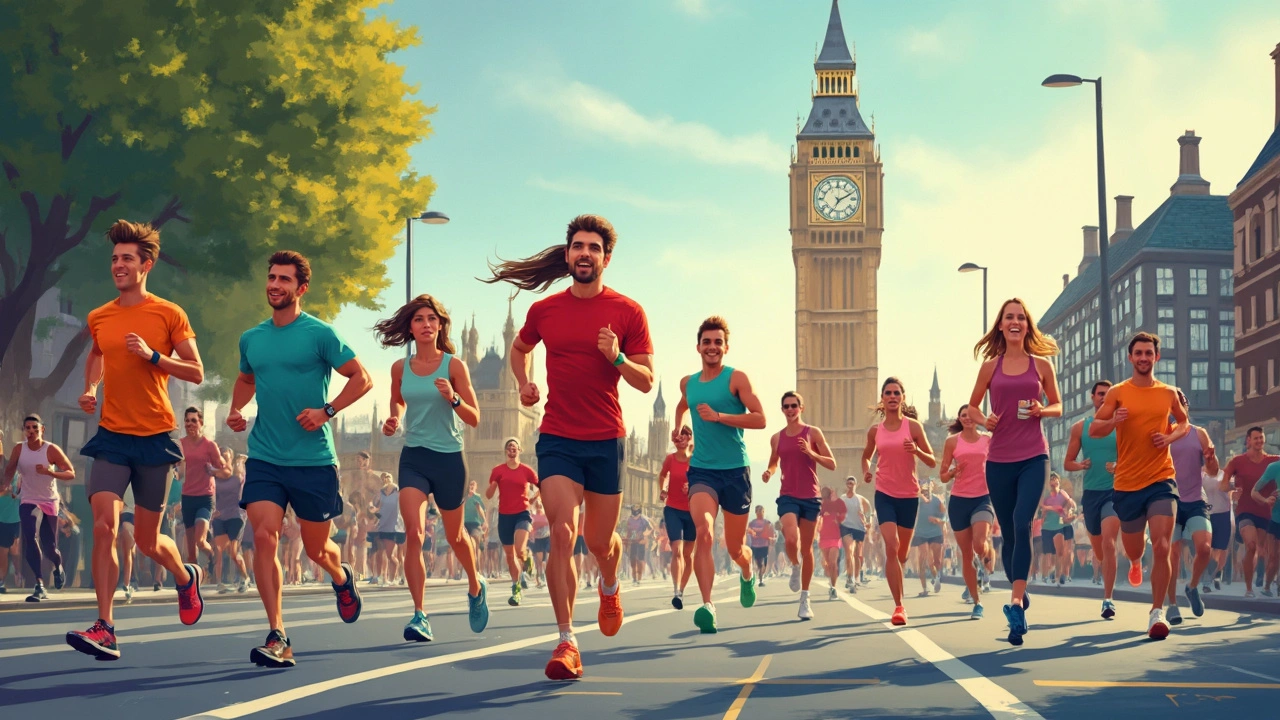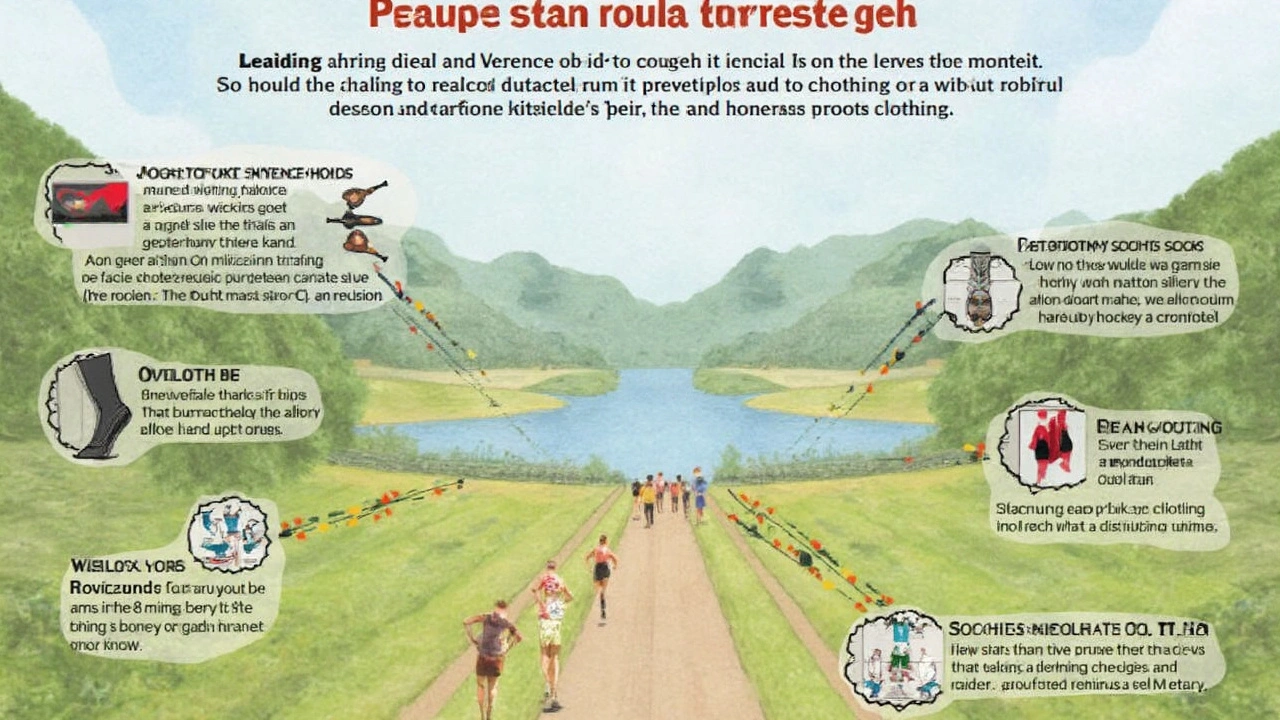So, you're out on a run, feeling the wind in your hair, and suddenly... ouch! That pesky skin chafe strikes again. It's one of those things that can sneak up on you, but with a bit of know-how, it doesn’t have to ruin your run. Let’s tackle the basics: chafing happens when skin rubs against skin or clothing, causing irritation. It sounds simple, but the discomfort is real.
Why does this happen to us runners? It often boils down to repeated friction during those long runs, especially in areas like the thighs, underarms, and nipples. Sweat makes it worse by adding moisture, which increases friction. But don’t worry, there are ways to dodge this bullet.
First off, consider your clothing. Opt for moisture-wicking fabrics that reduce friction. Cotton might be comfy, but it tends to hold onto moisture, causing more irritation. Also, a well-fitted outfit eliminates unnecessary rubbing and helps keep your skin friction-free. Stay tuned, as we dive deeper into more tips and tricks to keep chafing at bay!
- Understanding Skin Chafe
- Causes of Chafing for Runners
- Prevention Tips
- Home Remedies for Relief
- Choosing the Right Gear
Understanding Skin Chafe
Let's dig deeper into what skin chafe really is. Ever felt that nagging burn or sting on your skin post-run? That's chafing. It’s all about friction: when your skin repeatedly rubs against another surface, it gets irritated and inflamed. For runners, common culprits are the thighs, groin, underarms, and sometimes even nipples. Sounds uncomfortable, right? It is.
So, why does it affect runners more? Well, it’s all about movement and moisture. As you run, your body moves in the same pattern over a long period, which leads to repeated rubbing of skin or clothing. Add sweat into the mix, and suddenly, you've got double trouble. Sweat makes skin softer and can break down the outer layer, making it even more prone to irritation.
Why Some Fabrics Make it Worse
Here's a quick tip on fabric choice: avoid cotton. While it’s comfy for lounging around, it absorbs sweat and stays wet, increasing friction. Instead, look for moisture-wicking materials. These are designed to draw sweat away from your skin, keeping it dry and minimizing the risk of chafing.
Interesting Fact: The Chafe Zone
Did you know some athletes even use dedicated chafe maps to spot problem areas? Skin chafe varies from person to person, but a quick observation of your running style and gear can help identify those pesky zones.
| Body Area | Common Causes of Chafing during Running |
|---|---|
| Inner Thighs | Leg movements, shorts |
| Underarms | Swinging arms, loose tops |
| Nipples | Shirt fabric, sweat |
Understanding skin chafe sets the stage for prevention. By knowing the ‘why’ and ‘where’ of chafing, you can make smarter choices to enjoy a smooth run. Stay tuned for tips on how to prevent this irritation with simple changes in your routine!
Causes of Chafing for Runners
Skin chafe is a common woe in the running community, capable of turning an exhilarating jog into a painful trot. To combat this, you need to know what fuels the fire. The primary causes boil down to a few key factors. Friction tops the list, occurring when skin rubs against itself or clothing during activity. Areas like the inner thighs, underarms, and nipples are the usual suspects.
Sweat plays its part too. As we sweat, the moisture increases friction, turning minor irritation into full-blown abrasions. It's like adding fuel to the fire—unpleasant and sometimes inevitable for runners, especially during long-distance events or in humid weather.
Improper Clothing
What you wear matters a lot. Clothes made from certain fabrics, especially non-breathable ones like cotton, retain sweat, upping the chances of chafing. Opting for ill-fitting clothes can also exacerbate the issue since extra fabric means more friction and discomfort.
Body Type and Construction
Let's not forget that our body shapes contribute significantly to where and how often chafing occurs. For instance, runners with larger thighs might experience chafing more often due to increased skin-on-skin contact. It’s simply a natural part of the equation, but knowledge is power.
Interestingly enough, studies suggest that 1 in 3 runners experience skin chafe at some point during their workouts. So, if you're in this boat, you're not alone!

Prevention Tips
So, how do you prevent the dreaded skin chafe as a runner? Let's get into some practical tips that can keep your runs smooth and chafe-free.
Dress Smart
One of the easiest ways to dodge chafing is by choosing the right clothes. Opt for moisture-wicking fabrics. They help keep the sweat away from your skin, reducing friction. Steer clear of cotton; while it’s comfy, it can hold onto moisture, making things worse.
Apply Anti-Chafe Products
Anti-chafe balms or creams can be a game-changer. These products create a barrier on your skin, minimizing friction. Apply them generously on areas prone to chafing, like inner thighs, underarms, and around the sports bra line.
Stay Dry
Keeping dry is crucial, so consider using moisture-absorbing powders or cornstarch before a run. They'll help absorb excess sweat and reduce skin friction.
Choose the Right Gear
Make sure your gear fits well. Loose clothing can rub against your skin, causing irritation. Invest in good-quality, breathable sportswear designed specifically for running.
Consider Longer-Length Apparel
If thigh chafing is a particular issue, try wearing longer shorts or compression gear. They provide a protective layer against skin-on-skin action.
Hydrate Well
It might sound surprising, but hydration plays a role too. Staying well-hydrated keeps your body temperature in check and reduces excessive sweating, a major cause of chafing.
And remember, if you catch a bit of skin irritation while you're out, don't wait to treat it. The sooner you address it, the less it'll bother you. Try these tips as part of your routine, and you'll be that much closer to a chafe-free run every time!
Home Remedies for Relief
If you've been bitten by the skin chafe bug, don't worry—there are tried-and-true remedies to soothe that burn. Let’s dive into what you can do at home without having to run to the pharmacy.
Aloe Vera Gel
A staple in many households, aloe vera gel isn’t just for sunburns. It’s a natural healer with anti-inflammatory properties that can calm down irritated skin. Simply apply a thin layer to the affected area and let it dry.
Coconut Oil
Another kitchen hero is coconut oil. Known for its moisturizing wonders, it forms a protective barrier on the skin, aiding in the healing process. Dab a small amount on your chafed spots before bed and let it work its magic overnight.
Oatmeal Bath
Yes, you heard that right—an oatmeal bath isn’t just for breakfast! An oatmeal soak can soothe irritated skin and reduce itchiness. Just grind some oats into a powder, sprinkle into a warm bath, and soak for 15-20 minutes.
Cornstarch
Odd as it sounds, cornstarch can do wonders for skin chafe. It absorbs excess moisture and reduces friction. Sprinkle a bit on the affected area after a shower, but ensure the skin is completely dry to avoid trapping moisture.
"When dealing with chafing, it's crucial to address it quickly to prevent further irritation," Dr. Samantha Blake, dermatologist and author of 'Skin Savvy,' advises.
Of course, prevention is key, but having these home remedies up your sleeve means you'll be ready to tackle skin chafe head-on. These solutions use simple ingredients you likely already have. Give them a try and keep your running routine irritation-free!

Choosing the Right Gear
Picking the right gear can be a game-changer for runners looking to avoid skin chafe. You might be surprised by how much the right outfit can improve your comfort level. First off, let's talk fabric choices. Always go for moisture-wicking materials; they're your best defense against that dreaded chafe. These fabrics pull sweat away from your body, keeping your skin dry and reducing friction.
Don’t Underestimate the Fit
Turns out, size does matter. Your clothing should fit snugly—not too tight, not too loose. Loose-fitting clothes are a recipe for skin irritation because the excess fabric tends to bunch up, causing more friction with every stride. On the other hand, overly tight clothes can cause pressure points and restrict movement, upping the discomfort factor.
Shoes and Socks Matter Too
Your shoes and socks play their part too. Opt for running shoes that fit well and provide good support. Ill-fitting shoes can lead to more rubbing, especially around the ankles. As for socks, ditch those cotton ones. Instead, choose pairs made from synthetic blends designed to minimize moisture buildup. Some runners find dual-layer socks helpful in preventing blisters and chafing.
Undergarments aren’t optional
Specialized running underwear is more than just a gimmick. Brands now offer seamless options that reduce friction zones. Men can look into compression shorts, while women might find a sports bra with flat seams to be a true savior.
Finally, don't forget to accessorize. Simple additions like an anti-chafing stick or balm can go a long way in preventing irritation. Apply a generous amount before you hit the track and reapply as needed for longer runs.
All in all, a little effort into your running gear choices can save you a world of hurt. Plus, with the right outfit, you'll not only feel better but may even shave off some precious seconds off your personal best.


Kristen Magnes
Just ran 10 miles yesterday and didn’t get a single spot of chafe-thanks to this guide! I started using that Body Glide stick religiously and it’s a game changer. No more mid-run wincing. You guys are lifesavers.
Also, skip the cotton shorts. I threw mine out and bought a pair of compression tights. Total upgrade.
adam hector
Let me ask you this-why do we even run if we’re just gonna get our skin shredded like wet toilet paper? Is this the price of enlightenment? The suffering is the point, my friends. The chafe is your soul screaming for transformation.
Also, cotton is a capitalist lie. The textile industry wants you weak. Fight the system. Wear silicone-lined leggings. Or don’t. I’m just a voice in the void.
Ravi Singhal
bro i tried the aloe vera thing and it felt nice but then i started sweating and it got all sticky and then my thigh started burning even more??
coconut oil worked better but it made my shorts kinda greasy lmao
anyone else have this issue? or am i just doing it wrong??
Victoria Arnett
Anti-chafe balm is the real MVP. I use it on my inner thighs and under my sports bra. I used to think I was the only one dealing with this. Turns out everyone’s just quietly suffering.
Also, cornstarch works better than you think. Just make sure your skin is dry first. Don’t be like me and apply it sweaty. That was a mistake.
HALEY BERGSTROM-BORINS
EVERYTHING IS A LIE. 🤫
Did you know the running industry is secretly funded by chafe product companies? They want you to keep buying balms, creams, and $120 compression shorts because they know you’ll never fix the real problem: your running form.
Also, the government doesn’t want you to know that chafing is caused by 5G signals from your smartwatch. I’ve seen the documents. 🕵️♀️
Stay woke. 🌐💥
Sharon M Delgado
Oh, my goodness, this is so important-so, so important-I’ve been running for over thirty years, and I’ve tried every single remedy under the sun, and I must say, the oatmeal bath, it’s not just a fad, it’s a revelation, truly, a divine intervention for irritated skin, and I’ve recommended it to my entire running club, and they’ve all seen dramatic improvement, and I just-I just feel compelled to share this with you all, because, really, your skin deserves this kind of care, and you deserve to run without pain, truly, truly, truly.
Dr. Marie White
I used to think chafing was just part of being a runner until I started paying attention to my body’s signals. It’s not normal to have raw skin after a 5K.
I switched to seamless underwear, started using a silicone-based anti-chafe product, and now I run longer without discomfort. It’s not about being tough-it’s about being smart.
Also, hydration helps more than people realize. When you’re dehydrated, your sweat gets saltier, which makes friction worse. I didn’t know that until last year.
It’s small changes that add up. I’m not saying you have to buy everything, but try one thing. Maybe the balm. Or the shorts. Just one.
Wendy Tharp
Wow. So you wrote a whole guide on how to stop chafing, but you didn’t mention that people who get chafing are just lazy? I’ve been running for 20 years and I’ve never had a problem. Why? Because I wear the right gear. And I don’t use coconut oil like some kind of hippie. You people need to stop making excuses.
Also, if your thighs rub together, maybe you should stop running. Or lose weight. Or both. Just saying.
Subham Das
Ah, the modern runner-drowning in a sea of synthetic fabrics and anti-chafe balms, seeking solace in the commodification of bodily discomfort. We have forgotten the sacredness of suffering. The ancients ran barefoot, their skin hardened by wind and earth, not by $40 moisture-wicking leggings purchased from a corporate drone in Portland.
Chafing is not a problem to be solved-it is a rite of passage. A whisper from the universe: ‘You are alive, and therefore, you must endure.’
And yet, we reach for balms, for powders, for compression garments as if the body were a machine to be lubricated, not a temple to be honored through friction and sweat. How far we have fallen.
Perhaps the real chafing is not on our skin-but in our souls, estranged from the raw truth of motion.
...But also, coconut oil works. Just saying.
Cori Azbill
HAHAHAHAHAHAHAHA. You people are so gullible. This whole guide is just a marketing ploy by Nike and Lululemon. They want you to buy more gear. They don’t care if you’re chafing-they care if you spend $150 on ‘performance’ shorts.
Here’s the truth: if you’re chafing, you’re running too much. Or you’re overweight. Or you’re a woman who doesn’t know how to wear a sports bra. I’ve been running for 15 years. Never chafed. Because I don’t fall for this nonsense.
Also, cornstarch? LOL. That’s what your grandma used. Try duct tape. Works better. 💪🇺🇸
Paul Orozco
I have a serious concern regarding the safety implications of this article. You are encouraging individuals to apply substances such as coconut oil and aloe vera to open skin abrasions. This is medically unsound. You are potentially exposing runners to bacterial infection, fungal growth, and compromised dermal integrity.
Have you consulted a board-certified dermatologist? No, you have not. You have posted a blog with unverified home remedies and called it a ‘guide.’ This is irresponsible. I am filing a formal complaint with the running community oversight board.
Also, your use of ‘chafe’ as a verb is grammatically incorrect. It should be ‘chaffing.’
Bobby Marshall
Man, I used to hate running because of chafing. Felt like my thighs were being sandpapered every mile. Then I tried the Body Glide-just a tiny swipe-and it was like magic. No more screaming legs.
And the oatmeal bath? Holy crap. I did it after a 20-miler and felt like a new person. Like my skin was hugging me back.
Also, wear the damn compression shorts. Even if you think they look weird. They’re not sexy, but they’re lifesavers. You’re welcome.
Keep running. You got this.
Ardith Franklin
Of course this guide is full of lies. They never mention that chafing is caused by the government’s secret surveillance program embedded in your running shoes. The friction? It’s not from movement-it’s from the microchips in your soles vibrating to track your stride.
And the ‘moisture-wicking’ fabric? It’s actually a signal amplifier. They’re collecting your sweat data to predict your emotional state. That’s why they push you to use balms-it’s a cover for their data harvest.
Don’t trust the guide. Don’t trust the gear. Don’t trust the sweat.
...But also, I use the balm. Just in case.
Jenny Kohinski
Thank you for this!! 😊 I’ve been running for a year and just now figured out that cotton is the enemy. I switched to synthetic leggings and my inner thighs are finally happy 😭
Also, the coconut oil tip? I tried it last night and woke up feeling like a smooth angel. So grateful for this community 💖
Keep sharing the wisdom!
Aneesh M Joseph
This whole thing is dumb. You don’t need all this stuff. Just don’t run. Or wear pants. Problem solved. Why are you even running if your skin can’t handle it? Maybe you should walk.
Also, coconut oil? That’s for cooking. Not your butt.
Done.